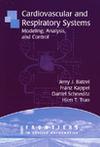Cardiovascular and Respiratory Systems心血管和呼吸系统的建模,分析和控制
出版时间:2006-12 作者:Batzel, Jerry J./ Kappel, Franz/ Schneditz, Daniel/ Tran, Hien T. 页数:274
内容概要
The human cardiovascular and respiratory control systems represent an important focal point for developing physiological control theory because of the complexity of the control mechanisms involved, the interaction between cardiovascular and respiratory funcÂtion, and the importance of this interaction in many clinical situations. This volume brings together the range of control processes involved in the effective regulation of these systems and develops modeling themes, strategies, and key clinical applications using contemporary mathematical and control methodologies. The reader will gain an appreciation of how analytical techniques and ideas from optimal control theory, systems theory, and numerical analysis can be utilized to better understand the regulation processes in human cardiovascular and respiratory systems. Cardiovascular and Respiratory Systems: Modeling, Analysis, and Control uses a principle-based modeling approach and analysis of feedback control regulation to elucidate the physiological relationships. Models are arranged around specific questions or conditions, such as exercise or sleep transition, and are generally based on physiological mechanisms rather than on formal descriptions of input-output behavior. The authors ask open questions relevant to medical and clinical applications and clarify underlying themes of physiological control organization. Current problems, key issues, developing trends, and unresolved questions are highlighted. Researchers and graduate students in mathematical biology and biomedical engineering will find this book useful. It will also appeal to researchers in the physiological and life sciences who are interested in mathematical modeling. List of Symbols and Abbreviations; Preface; Chapter 1: The Cardiovascular System under an Ergometric Workload; Chapter 2: Respiratory Modeling; Chapter 3: Cardiorespiratory Modeling; Chapter 4: Blood Volume and the Venous System; Chapter 5: Future Directions; Appendix A.
作者简介
Jerry J. Batzel is Research Associate at the Institute for Mathematics and Scientific Computing at the University of Graz, Austria.
书籍目录
List of Symbols and AbbreviationsPreface1 The Cardiovascular System under an Ergometric Workload 1.1 Some Physiological Facts 1.2 The Basic Model 1.3 Analysis of the Basic Model 1.3.1 Existence of equilibria 1.3.2 An invariance property of Grodins' system 1.4 The Linear-Quadratic Regulator Problem 1.5 The Bicycle Ergometer Test 1.6 Parameter Identification 1.6.1 A priori determined parameters 1.6.2 The output least-squares formulation of the parameter identification problem 1.7 Numerical Results 1.7.1 Parameter identification 1.7.2 Gradient computations 1.7.3 Sensitivity analysis2 Respiratory Modeling 2.1 Respiratory Control Physiology 2.1.1 General features of respiration 2.1.2 The chemical control system for ventilation 2.1.3 Structural features of ventilation 2.1.4 Blood gas transport 2.1.5 Respiratory control stresses and problems 2.1.6 Approaches to modeling respiratory control 2.2 Respiratory Control Model 2.2.1 The lung compartment 2.2.2 The tissue compartment 2.2.3 The brain compartment 2.2.4 Dissociation relations 2.2.5 State delays 2.2.6 Empirical control equation 2.2.7 Minute ventilation and tidal volume 2.2.8 Cardiac output and CBF 2.3 Stability of Respiratory Control 2.3.1 Computation of the delays 2.3.2 Stability and delays 2.4 Modeling Applications 2.4.1 Sleep and PB 2.4.2 PB and high altitude 2.4.3 Respiratory complications of HF 2.4.4 Other modeling issues3 Cardiorespiratory Modeling 3.1 Physiology Introduction 3.1.1 Global control of the CVS 3.1.2 Local control of the CVS and autorcgulation 3.1.3 Blood volume shift 3.1.4 Interaction of CVS and RS control 3.2 The Combined Model 3.2.1 Model equations 3.2.2 State dependency of the delays 3.2.3 Control formulation 3.2.4 Steady-stdte relations 3.3 Modeling Applications 3.3.1 CHF 3.3.2 Orthostatic and k B NP stress 3.3.3 Blood volume control and hemorrhage 3.3.4 CBF and OID4 Blood Volume and the Venous System 4.1 Introduction 4.2 Scaling 4.2.1 Isometric relationships 4.2.2 Allometric relationships 4.2.3 Cardiovascular entities 4.3 The Venous System 4.4 Capacitance 4.4.1 Passive mechanisms 4.4.2 Active mechanisms 4.4.3 Flow effects 4.4.4 Modeling and measurement 4.4.5 System of compliances 4.4.6 Mean circulatory filling pressure 4.4.7 Parallel arrangement 4.5 Blood Volume ……5 Future DirectionsA Supplemental CalculationsB A Nonlinear Feedback LawC Retarded Functional Differential Equations:Basic TheoryBibliographyIndex
图书封面
评论、评分、阅读与下载
Cardiovascular and Respiratory Systems心血管和呼吸系统的建模,分析和控制 PDF格式下载
用户评论 (总计0条)
推荐图书
- 勇敢的猪 Brave Pig
- 侦探
- 小龙与神奇的马车LITTLE DRAGON AND THE MAGIC WAGON
- 过家家
- The Mouse & the Monster老鼠与鬼怪
- The Pot of Gold一坛金子
- Electrical estimator’s manual电气估计员手册
- Sheaves in topology拓扑学中的层
- Gewohnliche Differentialgleichungen普通微分方程
- Examples and theorems in analysis在分析中的例子和定理
- Caught by disorder无序介质的束缚态
- The Galaxies of the Local Group本星系群
- Intersubjective Communication and Emotion in Early Ontogeny个体发育早期的主观交流与情绪
- Quantized Vortices in Helium II氦的量子漩涡 II
- 湖湘陶瓷
- Writing and Learning in the Science Classroom科学课堂中的协作与学习
- International Institutions and National Policies国际机构与国家政策
- Philosophy and the Law of Torts民事侵权法中的哲学
- Relevant logic相关逻辑
- Fighting the War on File Sharing文件共享之争
- African American Religious Leaders非裔美籍宗教领袖
- 商务秘书概论
- 防水工(中级)
- 防水工(中级)
- 英烈传/中国通俗小说名著分类文库
相关图书
- 中国粮食产量波动与政策分析
- 2007-2008南亚报告
- 新疆拒绝邪教
- 物理微格教学
- 新疆出版改革与实践(第二辑)
- 小学生道德教育读本
- 英语轻松学·听力步步通·八年级下
- 春天一过就走开
- 新闻与传播评论
- 寸心书屋曲谱
- 病理学实验指导
- 组织学与胚胎学
- 集束学习法
- 中学教材全解2012最新版高中生物选修3-现代生物科技专题
- 金星教育·中学教材全解(9年级上册)
- 高中生物·必修3学习细节
- 高中历史
- 高中语文
- 中国高中学生学习方法博览·初中英语
- 2006-2007中国建筑设计年度报告
- Muslim Legal Thought in Modern Indonesia现代印尼的穆斯林法律思想
- Critical Perspectives on Activity从批评视角看行为
- 新疆投资指南
- 长发公主 Rapunzel
- 机器人的故事 Story of Robots
